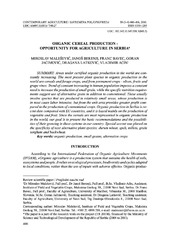Приказ основних података о документу
Organic cereal production: Opportunity for agriculture in Serbia
Organska proizvodnja žitarica - prilika za poljoprivredu Srbije
| dc.creator | Malešević, Miroslav | |
| dc.creator | Berenji, Janoš | |
| dc.creator | Bavec, Franc | |
| dc.creator | Jaćimović, Goran | |
| dc.creator | Latković, Dragana | |
| dc.creator | Aćin, Vladimir | |
| dc.date.accessioned | 2021-04-26T18:37:02Z | |
| dc.date.available | 2021-04-26T18:37:02Z | |
| dc.date.issued | 2010 | |
| dc.identifier.issn | 0350-1205 | |
| dc.identifier.uri | http://fiver.ifvcns.rs/handle/123456789/800 | |
| dc.description.abstract | Areas under certified organic production in the world are constantly increasing. The most present plant species in organic production in the world are cereals and forage crops, and from permanent crops - olives, fruits and grape vines. Trend of constant increasing in human population imposes a constant need to increase the production of small grain, while the specific nutrition requirements suggest use of alternative grain in addition to conventional. These usually involve species that are produced in relatively small areas, whose production is in most cases labor intensive, but from the unit area provides greater profit compared to the production of conventional crops. Organic production in Serbia is recent date compared with EU countries, and it is based mainly on the production of vegetable and fruit. Since the cereals are most represented in organic production in the world, our goal is to present the basic recommendations and the possibilities of their growing in these systems in our country. Special accent was placed on the specificity of next alternative plant species: durum wheat, spelt, millets, grain sorghum and buckwheat. | en |
| dc.description.abstract | Površine pod sertifikovanom organskom proizvodnjom u Svetu se konstantno povećavaju. Od njivskih kultura, u organskoj proizvodnji najzastupljenije su žitarice i krmno bilje, a od višegodišnjih zasada masline, voće i vinova loza. Stalni porast ljudske populacije nameće konstantnu potrebu za povećanjem proizvodnje žita, dok istovremeno specifični zahtevi tržišta u ishrani nameću potrebu da se pored konvencionalnih koriste i alternativna žita. Organska proizvodnja u Srbiji novijeg je datuma u odnosu na zemlje EU, a intenzivirana je uglavnom u proizvodnji povrća. Obzirom da su žita najzastupljenije vrste u organskoj proizvodnji u Svetu, cilj nam je da iznesemo osnovne postavke i mogućnosti njihovog gajenja u ovim sistemima i u našoj zemlji. Poseban akcenat dat je na specifičnostima 'alternativnih' vrsta; kao što su durum pšenica, spelta, kamut, tritikale, razne vrste prosa, sirak za zrno i heljda. | sr |
| dc.publisher | Univerzitet u Novom Sadu - Poljoprivredni fakultet, Novi Sad i Naučni institut za ratarstvo i povrtarstvo, Novi Sad | |
| dc.rights | openAccess | |
| dc.source | Savremena poljoprivreda | |
| dc.subject | organic production | en |
| dc.subject | small grains | en |
| dc.subject | alternative crops | en |
| dc.subject | organska proizvodnja | sr |
| dc.subject | žita | sr |
| dc.subject | alternativna žita | sr |
| dc.title | Organic cereal production: Opportunity for agriculture in Serbia | en |
| dc.title | Organska proizvodnja žitarica - prilika za poljoprivredu Srbije | sr |
| dc.type | article | |
| dc.rights.license | ARR | |
| dc.citation.epage | 416 | |
| dc.citation.issue | 3-4 | |
| dc.citation.other | 59(3-4): 400-416 | |
| dc.citation.rank | M51 | |
| dc.citation.spage | 400 | |
| dc.citation.volume | 59 | |
| dc.identifier.fulltext | http://fiver.ifvcns.rs/bitstream/id/1641/797.pdf | |
| dc.identifier.rcub | https://hdl.handle.net/21.15107/rcub_fiver_800 | |
| dc.type.version | publishedVersion |


